
![Ver [Valero de Bernabé, L.; 2009b] en referencias bibliográficas. Libro abierto, hojas de plata, filo de oro, guardas de gules, tapas de sable.](../css/Libro.Bibliografia.png)
Valero de Bernabé, L.; 2009b
Luis Valero de Bernabé y Martín de Eugenio, «Los Castillos en la Heráldica», Magazine of the Real Asociación de Hidalgos de España, «La Gacetilla de Hidalgos de España», number 524, pages 32, 33 and 34. Madrid, October, November and December 2009.
Bibliographical reference of century XXI.
Author: Valero de Bernabé y Martín de Eugenio, Luis.
Bibliographic reference mentioned in the following articles:
- Alfonso VIII of Castile, royal crown
- Edward IV of England; 1461
- Royal Association of Hidalgos of Spain
- Valero de Bernabé, L.; 2009a
External link:
Internal resources: ValeroBernabeL2009.520.RevistaCompleta.pdf.


![Ver [Vivar del Riego, J. A.; 2007] en referencias bibliográficas. Libro abierto, hojas de plata, filo de oro, guardas de gules, tapas de sable.](../css/Libro.Bibliografia.png)
Vivar del Riego, J. A.; 2007
José Antonio Vivar del Riego, Diplomado en Genealogía Heráldica y Nobiliaria, «El Blasón Escrito: La Historia de los Libros de Heráldica», lecture, 31st of May of 2007.
Bibliographical reference of century XXI.
The author is Vivar del Riego, José Antonio.
External resource:
Internal resources: VivarDelRiegoJA2007.HistoriaLibrosHeraldica.pdf.


Leonor Plantagenet
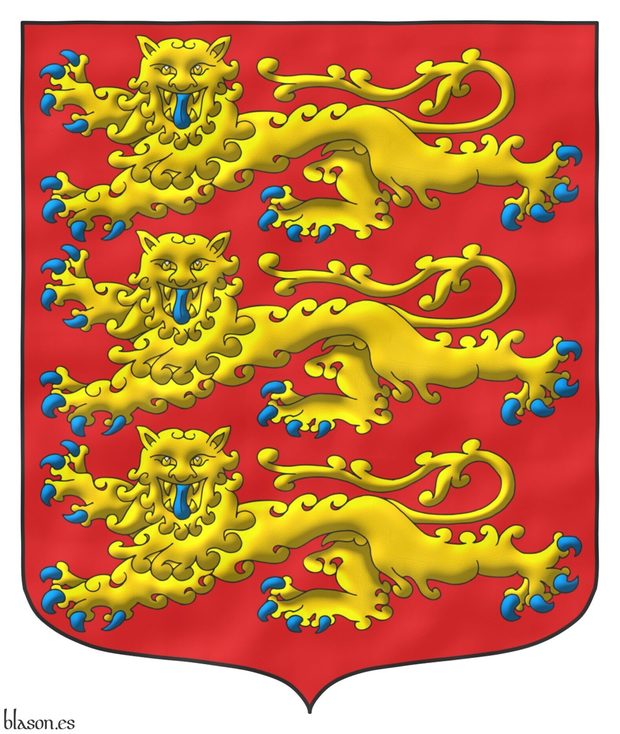
Gules, three lions, passant, guardant, in pale Or, armed and langued Azure.
Escudo de gules, tres leopardos en palo de oro, armados y lampasados de azur.
Existing armorial bearings interpreted as follows: the shape of the shield is pointed and rounded; the field has been enamelled in flat Gules; the three leopards are outlined in Sable and illuminated in metal Or with details in Azure; and the whole composition has a watercolor finish..
In [Humphery-Smith, C.; 1983; paragraph 2] the coat of arms of Eleanor Plantagenet, Queen Consort of Castile, is described, as part of an analysis on the origin of the three leopards in the coat of arms of England. However, in this description, an error is made by replacing the V with an X in the numeral of her husband and king, thus naming Alfonso VIII of Castile as if he were King Alfonso XIII: «Eleanor who married Alfonso XIII, King of Castile and Leon, has depicted on her tomb in the Huelgas monastery of the Cistercian nuns at Burgos, a thirteenth-century shield depicting three crowned leopards (lions passant guardant) gold on red».
Blazon keywords: Without divisions, Gules, Or, Azure, Three, Leopard, Armed, Langued and In pale.
Style keywords: Ogee, Illuminated, Outlined in sable and Watercolor.
Classification: Interpreted, Personal, Coat of arms, House of Plantagenet, Kingdom of England and Kingdom of Castile.
Bearer: Leonor Plantagenet.


Leonor Plantagenet, corona real abierta
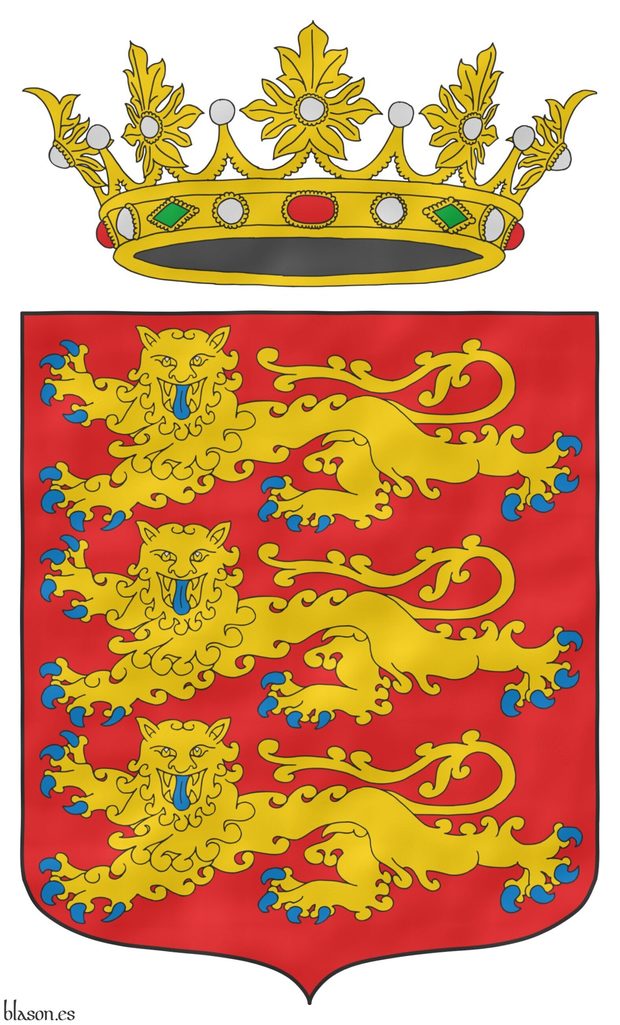
Princess of England and Queen Consort of Castile from 1170 to 1214.
Gules, three lions, passant, guardant, in pale Or, armed and langued Azure. Crest: An open royal crown Or.
Escudo de gules, tres leopardos en palo de oro, armados y lampasados de azur. Timbrado de una corona real abierta.
Armorial bearings of the queen interpreted by me as follows: the shape of the shield is pointed and rounded; both the field, the three leopards, and the open royal crown have been enamelled with flat tints of gules and metal or, with details in azure, vert, and metal argent; the three leopards and the crown are outlined in sable; and the whole composition has a watercolor finish.
She was the daughter of Henry II of England and Eleanor of Aquitaine, wife of Alfonso VIII of Castile, and mother of 10 children documented in historical records, with her eldest daughter being Queen Berenguela of Castile.
Blazon keywords: Without divisions, Gules, Or, Azure, Three, Leopard, Armed, Langued, In pale, Crest, Open royal crown and Crown.
Style keywords: Ogee, Plain tincture, Outlined in sable and Watercolor.
Classification: Interpreted, Personal, Coat of arms, House of Plantagenet, Kingdom of England and Kingdom of Castile.
Bearer: Leonor Plantagenet.


Leonor Plantagenet and Alfonso VIII
[ Gules, a castle triple towered Or, port and windows Azure, masoned Sable ] accolé with [ Gules, three lions, passant, guardant, in pale Or, armed and langued Azure ].
[ Escudo de gules, un castillo de oro, aclarado de azur, mazonado de sable ] acolado de un [ escudo de gules, tres leopardos en palo de oro, armados y lampasados de azur ].
Arms of the King and Queen of Castile interpreted with: the escutcheons' shapes pointed and rounded; the field of each shield, the castle, and the three leopards enamelled in flat tints of Gules and metal Or, with windows, claws, and tongues in Azure; and the whole composition finished with a raised line technique.
[Medél, R.; 1846; page 38] provides a heraldic description of the leopard.
Blazon keywords: Without divisions, Gules, Or, Azure, Three, Leopard, Armed, Langued, In pale, Sable, One, Castle, Port and windows and Masoned.
Style keywords: Ogee, Plain tincture, Outlined in sable, Tilted shield and Freehand.
Classification: Interpreted, Personal, Accolé arms, House of Plantagenet, Kingdom of England and Kingdom of Castile.
Bearer: Leonor Plantagenet.


Ferdinand II of Leon
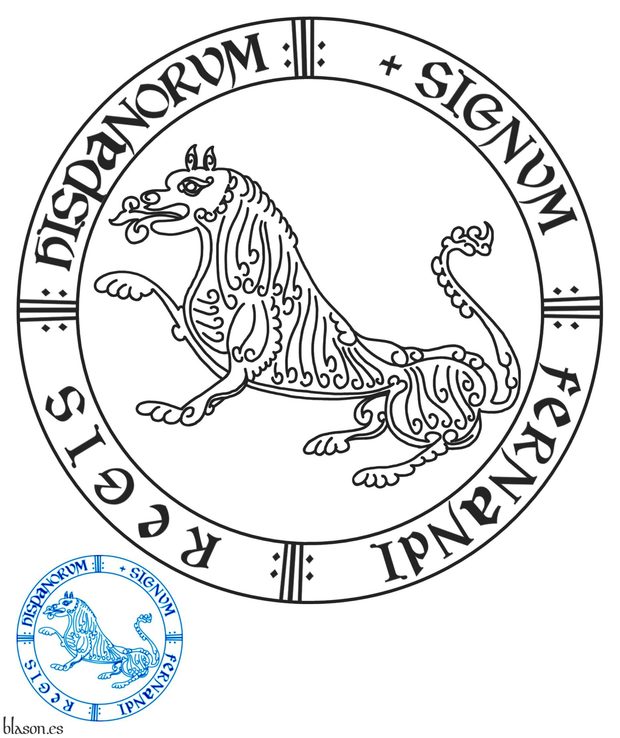
Round seal, a lion sejant. Circular motto: «Signum Fernandi Regis Hispanorum».
Sello rodado, un león sentado. Divisa circular: «Signum Fernandi Regis Hispanorum».
Existing seal interpreted by me as follows: the shape of the seal is circular; the motto is written in sable on its outer ring; inside, a seated lion that begins to be rampant and will eventually become so; y the whole rendered in flat sable ink; y the result is an impression in azure ink.
For the outline of the lion I have followed the round seal of the king in his «Charter of Benavente» [Fernando II de León; 1167], in which I consider the lion to be seated; although it could also be interpreted as rampant, or as intending to be so, as it will ultimately appear in the arms of his son, King Alfonso IX of León.
For the delineation of the motto I have followed the round seal of the king in his «Charter of the Alfoz of Benavente» [Fernando II de León; 1181], in which the lion, unlike the previous one, is clearly in a passant posture.
In [Martín Fuertes, J. A.; 2002] four other round seals of King Fernando II of León can be consulted:
- from the year 1160 (A.C. de León, number 4168) with a lion passant,
- from the year 1165 (A.C. de León, number 1041) with another lion passant,
- from the year 1168 (A.C. de León, number 170) with a lion statant, also described as arrested or at rest, as mentioned in [Avilés, J.; 1725a; page 37] and [Avilés, J.; 1780a; page 42].
- from the year 1187 (A.C. de León, number 1067) with a lion passant and regardant, that is, with its head turned toward the sinister side of the round seal, a posture described, for example, in [Avilés, J.; 1725a; page 55] and [Avilés, J.; 1780a; page 61].
In attitudes of the lion of Ferdinand II the attitudes discussed in this article are illustrated.
Blazon keywords: Without divisions, One, Lion, Sejant and Motto (identification).
Style keywords: Round, Plain tincture and Sealed.
Classification: Interpreted, Personal, Seal and Kingdom of León.
Bearer: Ferdinand II of Leon.


Ferdinand II, Signum Regis Hispanorum
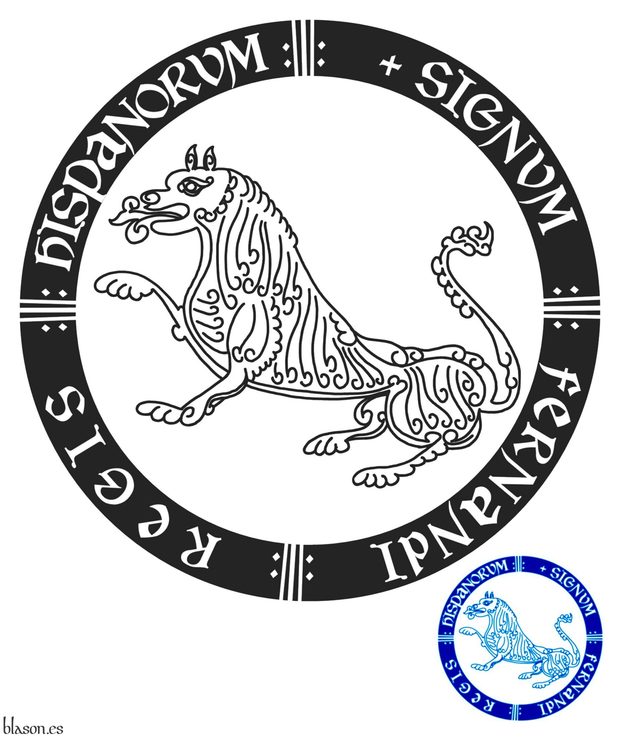
Born in 1137, King of León from 1157 to 1188, died in Benavente on January 22, 1188.
Round seal, a lion sejant. Circular motto: «Signum Fernandi Regis Hispanorum».
Sello rodado, un león sentado. Divisa circular: «Signum Fernandi Regis Hispanorum».
Existing seal interpreted by me as follows: the shape of the seal is circular; the legend is written within an outer black border; inside, a seated lion, not so much rampant and even less passant; the whole rendered in flat sable ink; and the result glazed with azure ink.
I use the term "legend" for its identifying purpose regarding King Fernando II of León; note that among the terms motto, legend, device, and war cry, all referring to texts in the blazon, different nuances and meanings can be found.
Blazon keywords: Without divisions, One, Lion, Sejant and Motto (identification).
Style keywords: Round, Plain tincture and Sealed.
Classification: Interpreted, Personal, Seal and Kingdom of León.
Bearer: Ferdinand II of Leon.


Ferdinand II, imaginary coat of arms
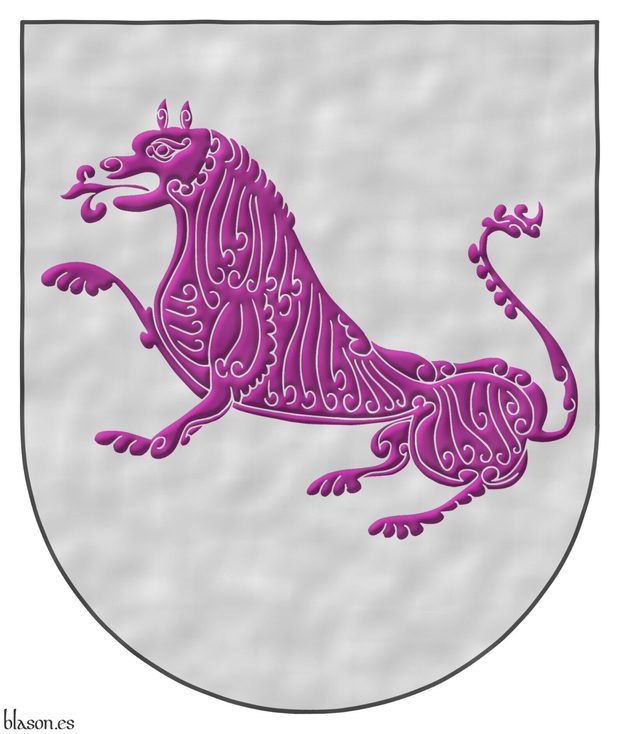
Argent, a lion sejant erect Purpure.
Escudo de plata, un león sentado de púrpura.
Imaginary coat of arms of King Fernando II of León, which I have developed based on his seal and the arms of his successor, with: the shape of the coat of arms is semi-circular; the field enameled in flat argent; the lion enameled in purpure and illuminated; and the whole rendered with a watercolor finish.
For this imaginary coat of arms I have chosen a representation of the lion in a posture similar to that of the great seal appearing in [Fernando II de León; 1167], which is sejant ~ «sentado» in Castilian, although beginning to rise «sejant erect».
It should be noted that we are in a pre-heraldic period where the possible attitudes of the lion were not yet clearly defined, although several of them are already anticipated in the great seals of Fernando II, as can be seen, for example, passant in [Fernando II de León; 1181] and in other attitudes in the photographs of [Martín Fuertes, J. A.; 2002].
Blazon keywords: Without divisions, Argent, Lion, Purpure and Sejant.
Style keywords: Semi-circular, Illuminated, Outlined in the field tincture and Watercolor.
Classification: Interpreted, Imaginary, Coat of arms and Kingdom of León.
Imaginary bearer: Ferdinand II of Leon.

Continue with: Attitudes of the lion of Ferdinand II.
-
Language
-
Categories of heraldry
-
Divisions of the field
- Without divisions
- Party per pale
- Party per fess
- Party per bend
- Party per bend sinister
- Tierce
- Tierce sinister
- Tierced per pale
- Tierced per fess
- Tierced per bend
- Tierced pallwise inverted
- Quarterly
- Quarterly per saltire
- Gyronny
- Party per fess, the chief per pale
- Party per pale, the sinister per fess
- Party per fess, the base per pale
- Party per pale, the dexter per fess
- Chapé
- Chaussé
- Embrassé
- Contre-embrassé
- Party per chevron
- Enté
- Enté en point
- Flanched
-
Metals
-
Colours
-
Furs
-
Other tinctures
-
Ordinaries and sub-ordinaries
-
Diminutives of the ordinaries
-
Other charges
-
Charges from Nature
Water, Eagle, Bald eagle, Eagle claw, Dorsal fin, Tail fin, Two hands clasped, Lark, Tree, Trunk, Rainbow, Atom, Barbel, Acorn, Bighorn sheep, Arm, Owl, Vulture, Horse, Head, Goat, Camellia, Thistle, Merino ram, Kapok tree, Stag, Doe, Crescent, Increscent, Chrysanthemum, Tail, Tail addorsed, Ermine spot, Hummingbird, Snowflake, Heart, Roe deer, Neck, Stags' attires, Roe deers' attires, Raven, Dolphin, Diamond, Tooth, Elephant, Trunk (elephant), Beetle, Emerald, Starling, Mullet, Mullet of four points, Star of David, Estoile, Male figure, Fleur de lis, Flower, Cornflower, Dogwood flower, Lotus flower, Hop cone, Bluebonnet, Puffin, Ash, Rooster, Claw, Talon, Goose, Heron, Seagull, Pomegranate, Sunflower, Swallow-tail, Falcon, Leaf, Boar, Goldfinch, Laurel, Barn owl, Lion, Lioness, Lion passant, Leopard, Lion rampant guardant, Lynx, Lily, Madonna lily, Flame, Wolf, She-wolf, Parrot, Moon, Hand, Apple, Apple tree, Sea, Martlet, Wing, Two wings in vol, Covert, Blackbird, Mount, Trimount, Fly, Wrist, Elm, Olive tree, Orbital, Bear, Palm frond, Palm tree, Dove, Poplar leaf, Panther, Jaguar, Vine, Paw, Forepaw, Foot (palmiped), Foreleg, Peacock, Chest, Pelican, Pelican in her piety, Dog, Brach hound, Warren hound, Fish, Hoof, Beak, Feather, Ostrich feather, Cinquefoil, Quetzal, Branch, Sprig, Frog, Shamrock, Caboshed, Oak, Holm oak, Rose, Double rose, Savage, Serpent, Plough of Ursa Major, Sun, Sun in splendour, Ray of the sun, Lightning flash, River, Stem, Badger, Tyger, Linden, Wheat, Wheat spike, Bull, Tulip, Udder, Escallop and Fox.
-
Artificial charges
Halberd, Plough share, Ace of spades, Anchor, Cyclamor, Torch, Bow, Arch, Harp, Non-classic artifact, Winnowing fan, Crozier, Conductor's baton, Pair of scales, Ship, Oar, Sail, Norman ship, Beret, Grenade, Ecclesiastical cap, Arm vambraced, Knight, Chain, Cup, Covered cup, Monstrance, Bell, Bell tower, Cannon, Cannon dismounted, Cannon port, Carbuncle, Castle, Ribbon, Clarion, Nail, Crucible, Cord, Dagger, Key ward, Turret, With a turret, Armillary sphere, Sword, Federschwert, Sabre, Parchment, Scroll, Skirt, Arrow, Club, Garb, Sheaf of tobacco, Scythe, Gauntlet, Axe, Buckle, Galician granary, Host, Bonfire, Polish winged hussar, Church, Fanon, Oil lamp, Spear, Spear's head, Fleam, Letter, Book, Open book, Closed book, Bookmark, Page, Line, Lantern, Key, Four crescents joined millsailwise, Hammer, Two-handed sword, Menorah, Mortar, Pestle, Number, Knot, Celtic Trinity knot, Water-bouget, Comb, Piano, Millstone, Millrind, Millwheel, Quill, Clay pot, Potent, Bridge, Cuffed, Hourglass, Chess rooks, Compass rose, Rosette of acanthus leaves, Mullet of six points pierced, Broken, Portcullis, Wheel, Wagon-wheel, Symbol, Sackbut, Drum, Loincloth, Geometric solid, Tetrahedron, Tower, Trident, Trumpet, Double vajra and Anvil.
-
Immaterial charges
Angel, Archangel, Basilisk, Heart enflamed, Sacred Heart of Jesus, Paschal lamb, Dragon's head, Dragon, Wyvern, Phoenix, Garuda, Griffin, Sea-griffin, Winged hand, Our Lady of Mercy, Pegasus, Saint George, Mermaid, Trinity, Triton, Golden fleece, Unicorn and Ouroboros.
-
External elements
-
Heraldic creations
-
References
-
Formats
-
Keywords on this page
Port and windows, Watercolor, Armed, Azure, Bibliography, House of Plantagenet, Castle, Crest, Round, Ogee, Regardant, Crown, Open royal crown, Outlined in sable, Outlined in the field tincture, Motto (identification), In pale, Coat of arms, Accolé arms, Sealed, Ferdinand II of Leon, Personal, Gules, Illuminated, Imaginary, Interpreted, Langued, Leonor Plantagenet, Leopard, Lion, Masoned, Semi-circular, Or, Statant, Passant, Argent, Without divisions, Purpure, Rampant, Kingdom of Castile, Kingdom of England, Kingdom of León, Tilted shield, Seal, Sejant, Century XXI, Plain tincture, Three and One.
![Leonor Plantagenet and Alfonso VIII [ Gules, a castle triple towered Or, port and windows Azure, masoned Sable ] accolé with [ Gules, three lions, passant, guardant, in pale Or, armed and langued Azure ].](../escudo_armas/LeonorP.23.Matrimonio.jpg)